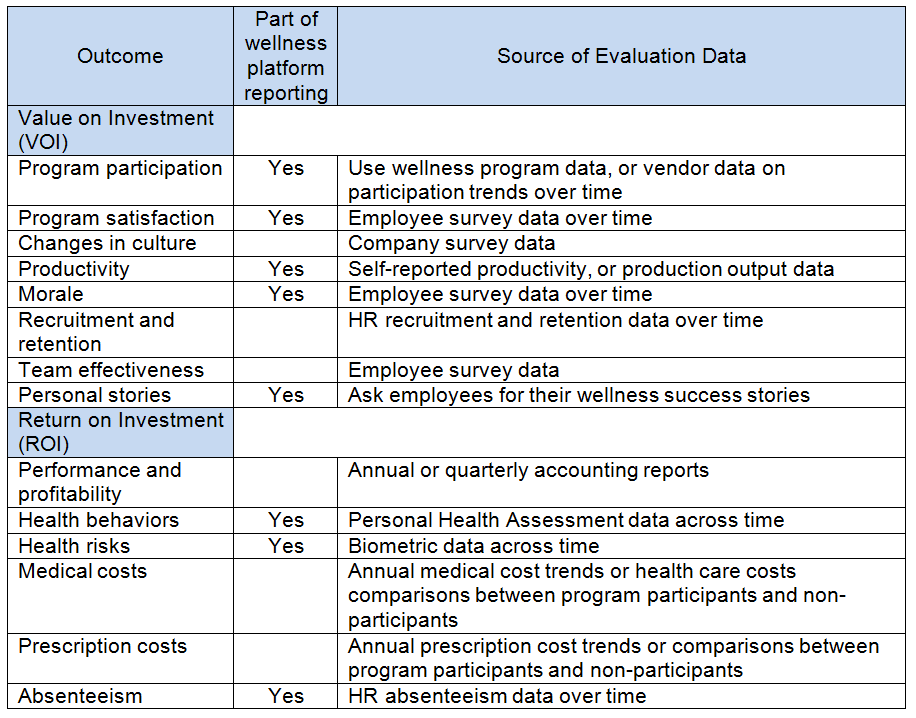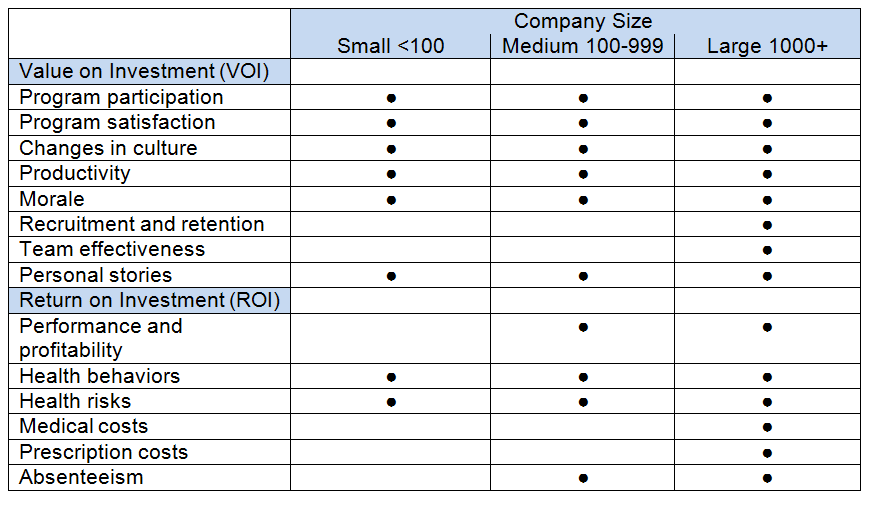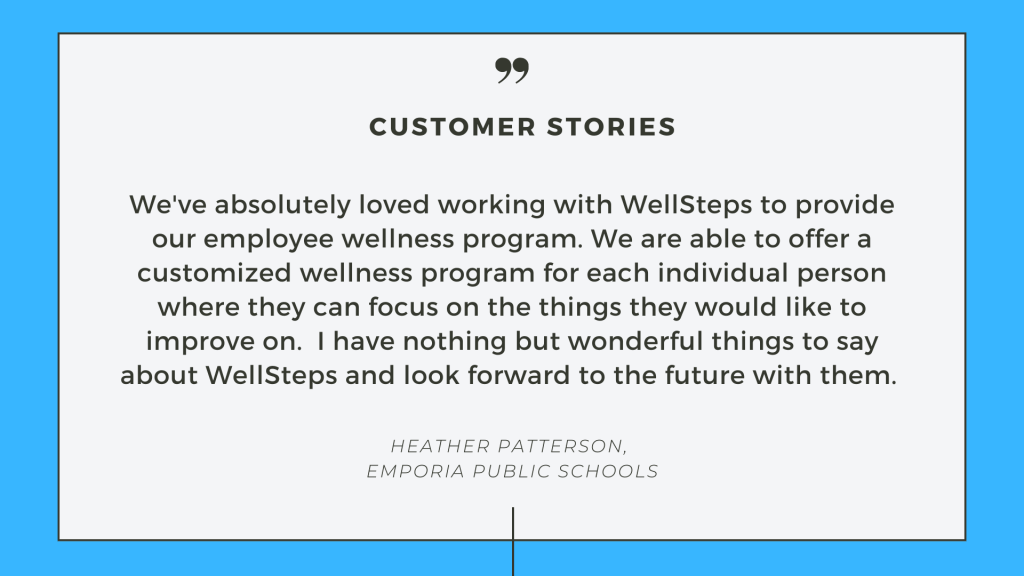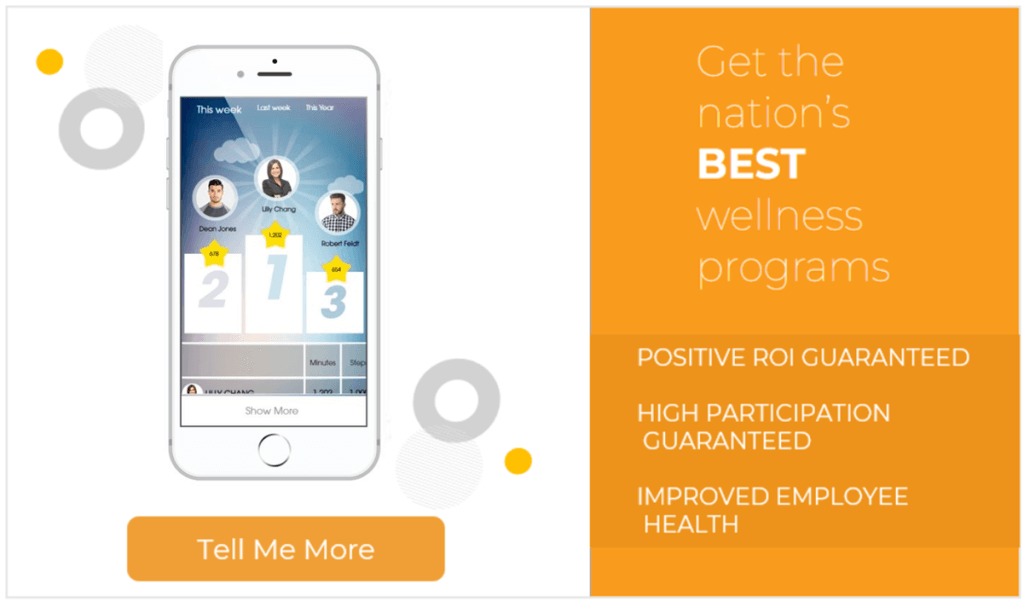Good wellness programs are continually improving their offerings. The process of continual improvement requires the use of program outcomes data to help determine program effectiveness. Here are 5 questions you should ask before you evaluate a wellness program.
Why Do You Want to Evaluate a Wellness Program?
Historically, company leaders have looked at wellness programs as a company perk rather than a defined employee benefit. As a perk, leaders asked for evaluations that determined wellness program value and whether these programs were worth the cost.
Today, wellness programs are less likely to be considered perks and are more likely to be considered part of a defined benefits package. Still, the employers who conduct wellness program evaluations want answers to questions like:
- How many employees and spouses participate?
- How many are earning incentives?
- Are health behaviors and health risks improving?
- Is company morale improving?
- Is the program saving the worksite more money than it costs?
- Do employees like the program?
- How can we make our wellness program better?
Every wellness program evaluation will find one of three outcomes: things improved, they got worse, or they didn’t change at all. What you need to decide now is what your response will be to each of these potential outcomes.
Whatever your reason for conducting an evaluation, it is helpful to think through each option before you conduct the evaluation.
RELATED: 10 Questions to Ask Before You Start a Wellness Program
What Should You Evaluate?
You should start by asking why you have a wellness program in the first place. There are several answers to this question. Interestingly, 91% of U.S. employers report offering health and well-being programs for reasons beyond medical cost savings.

While some employers start wellness programs to help control employee-related expenses like healthcare costs or improve productivity, over time, cost savings becomes less of a concern in most cases.
After several years of program participation, employers begin to see the value that wellness programs provide. “Value” is above and beyond reduction in employee related expenses. Added value can be determined in a Value On Investment (VOI) evaluation.
“Value” is above and beyond reduction in employee related expenses.
VOI is not easy to understand because the term is not very descriptive. Typically, wellness program outcome measures that are part of wellness VOI are self-reported, require additional data collection and expense, and can often be considered “softer” measures.
Some VOI metrics include:
- job satisfaction
- performance
- morale
Value can refer to anything that increases:
- productivity
- retention
- morale
- performance
Good worksite wellness programs impact employee morale, but how exactly can employee morale be quantified? The same could be asked about measuring team cohesiveness, recruitment, or retention. Value-based outcomes are hard to accurately measure.
RELATED: How Wellness Programs Help Improve Employee Morale
Quantifying Improvement Based on Value and Not Financials
A VOI analysis does not look at the same things as a wellness Return on Investment (ROI) evaluation. An ROI report answers the question of whether wellness is worth the investment.
By contrast, a VOI report assumes wellness investment but asks the question, “Where is the best place to start?” In other words, it wants to find out which emphasis will deliver the biggest “bang for the buck.”
The table below shows a list of common reasons for doing worksite wellness. They are divided into outcomes that are related to a wellness program’s ROI and VOI. The table also shows the type of data that can be used when you evaluate a wellness program.

Most wellness programs use an online platform to help administer and deliver their program. These platforms can instantly create evaluations of a variety of program outcomes. The table also shows which outcomes can be automatically evaluated with a digital wellness platform.
Some employers want to know how many employees are clicking on different pages. Tracking clicks is popular with today’s technology; however, wellness program effectiveness is better measured by:
- participation
- improvements in health behavior
- reductions in health risks
- positive return on investment
Clicks are nice and they show effective communications, but clicks don’t necessarily result in improved health.
RELATED: The Costs and Advantages of an Employee Wellness Program
Company Size is A Major Factor In Analysis
The outcomes to evaluate often vary by company size. Small companies with fewer than 100 employees will have a more difficult time conducting an ROI analysis because they don’t have enough employees to provide adequate data. Larger companies do have adequate data.
They also have the resources to evaluate pretty much any aspect of the program. These evaluations are time consuming and demand significant expertise, often requiring outside consultants.

The table shows various wellness outcomes to evaluate by the size of the company. In general, the smaller the organization the more difficult it is to do some evaluations.
RELATED: How To Make Small Business Wellness Programs Work
How Do You Evaluate a Wellness Program?
Your evaluation approach depends on the outcomes that you want to study. On the one hand, you can look at data at a single point in time and get a snapshot of that particular outcome at that particular moment.
For example, calculating the number of program participants is a great way to determine how much engagement your program is getting. At any point in time, a percentage of employees will be participating.
On the other hand, measuring changes across time provides more robust information. These types of evaluations have different names like pre-test/post-test, baseline/follow-up, or repeated measures. The idea is to evaluate if an outcome changes across time.
For example, if the number of employees with high blood pressure decreases during the same time your wellness program offers a hypertension control program, the improvement may be due to your wellness efforts.
The highest standard is generally considered to be a randomized clinical trial; however, randomizing some employees to receive the hypertension program while others are randomized to a control condition is simply not ethical.
The highest standard is generally considered to be a randomized clinical trial; however, randomizing some employees to receive the hypertension program while others are randomized to a control condition is simply not ethical.
So, while the pre-test/post-test evaluation might suggest that the program was effective, the improvements could be due to other things.
Perhaps the hardest part of actually doing the evaluation is getting accurate data. Getting data becomes much easier if your wellness program uses a web-based wellness platform.
Think of wellness platforms as data warehouses where all participant data is contained. These platforms can be used to:
- administer wellness programs
- schedule challenges
- gather biometric data
- administer incentives
- create reports
Used correctly, these platforms can provide enormous amounts of program evaluation data. If your program uses a wellness platform, you should be able to evaluate many of your program outcomes.
Below is a list of wellness program outcomes and possible sources where you might be able to locate data on those outcomes.
RELATED: What Happens After 2 Years of Employee Health and Wellness Programs
How Should You Interpret Your Findings?
Understanding your research is about figuring out what works, what doesn’t, and how sure you can be about it. This is important when you’re looking at wellness programs and is often where many problems arise.
One common approach to evaluate a wellness program is to look at the data from the people participating in the program at the start and then again later on. Many wellness program organizers just look at all the initial information and compare it to the follow-up results
However, there’s a problem with this method. The participants in the program at the beginning are not exactly the same participants at follow-up. Employees might leave because they retire, get fired, or move to another job, and new people might join. In some worksites, turnover rates can exceed 50% annually.
As a result, findings obtained from this kind of evaluation might not accurately show how well your wellness program is doing because the participants are constantly changing.
A more reliable strategy would involve only looking at the employees with data at the start and follow-up points in time during the program. While this may lead to a smaller sample size, the results are more likely to be precise and representative.
The credibility of your findings really depends on how carefully you evaluate. If your assessment uses data that’s not very good, then your results won’t be very reliable.
In short, understanding your findings means thinking about how the demographic of your program changes over time and making sure you use robust methods to evaluate properly for reliable results.
RELATED: 8 Workplace Health Promotion Program Examples That Work
What Should You Do with the Results of Your Wellness Program Evaluation?
This question can ultimately be answered by the wellness committee and company leadership. Here are a few suggestions: You can use the results from your evaluation to tweak any aspect of the program.
Every worksite should be working to enhance their wellness offerings. You can get rid of aspects of your program that don’t appear to be working or modify them to make them better.
The results from your evaluation can also be used to justify the existence of your program. Company leadership will probably appreciate any data like this.

Care should be taken interpreting your results. For example, employee obesity follows the same trends as public obesity. Over time, most populations are gaining weight.
As a result, wellness programs will have a difficult time helping employees achieve and maintain a healthy body weight. Thus, most wellness program evaluations will show that body mass index does not improve over time.
However, just because employees don’t lose weight over time does not mean that your program was a failure. It is a huge success when employees are not heavier at follow-up.
Since the public health trend is to gain weight, any wellness program that is able to help people keep their weight stable should be considered progress.
One of the most impactful aspects of your data is personal testimonials and comments. Human beings are emotional creatures. It’s great to have lots of empirical data, but nothing can replace the impact that comes from having individual employees comment on their wellness successes.
Don’t forget to get comments or stories from your wellness champions. Their experiences and improvements in health may provide some of the best outcomes your program can produce.
RELATED: Outcomes-based Wellness Programs: An Example from the Real World
So What’s Next?
Good wellness programs utilize wellness program evaluation to constantly make improvements. However, evaluations can take different forms and look at many different outcomes. Try to evaluate outcomes that were identified when you started your wellness effort and use the results to document your progress.
If this all seems overwhelming to you, we get it. Our WellSteps guides take all of that evaluation and analysis off your hands so that you can still see the results with your employees and company without the added stress or confusion. Discover how in a free demo with our team and we’d love to answer your questions!

Frequently Asked Questions
How do you measure the success of a wellness program?
In order to measure the success of a wellness program, its important to know that the core of every good wellness program is behavior change. With the right education, skills, motivation, skills/tools, and social support, people change behaviors. Wellness programs are good at helping people adopt and maintain healthy behaviors.
What should be included in a wellness program?
In short, the key elements of a good employee wellness program includes activities designed to support better employee health. Some of these key elements often include:
- medical screenings
- incentives for healthy behaviors
- behavior change interventions
- health coaching
- fitness
- nutrition
- weight loss programs
- social support
- gamified wellness challenges and much more